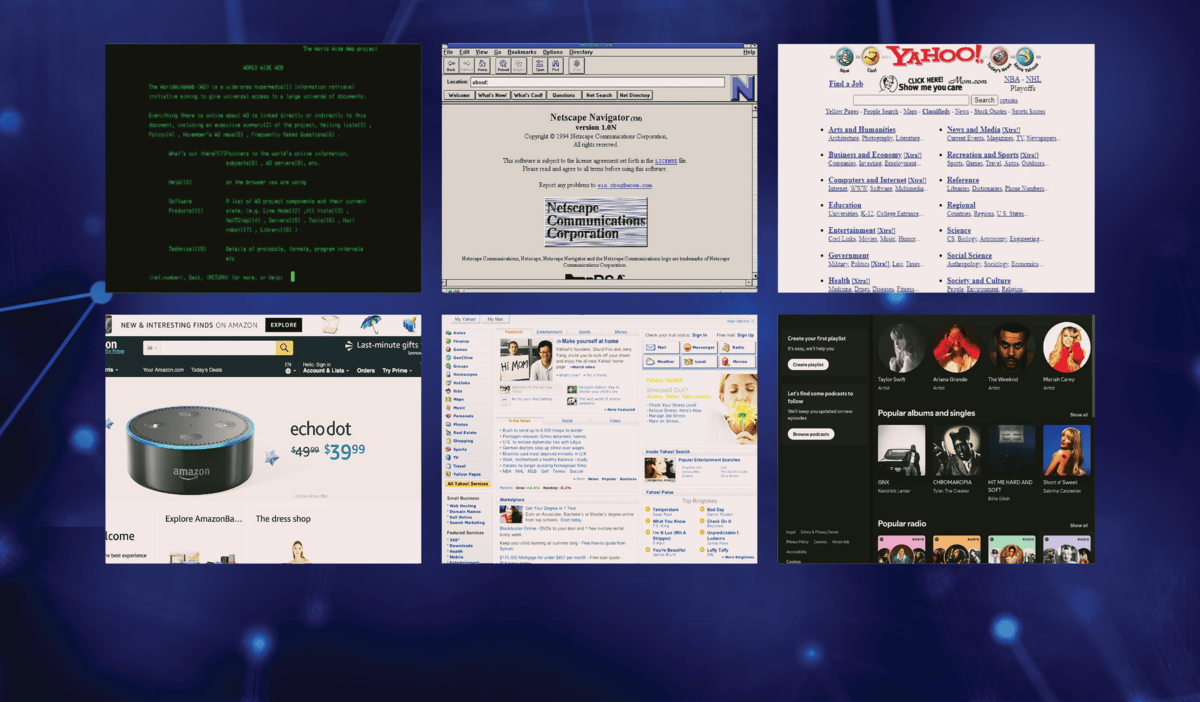The Homepage of the Future: Evolution, AI, and the End of Navigation
The evolution of web homepages reflects the internet’s transformation during the past 3 decades. From simple, text-based pages to sophisticated, AI-driven interfaces, homepages have adapted to meet changing user needs and technological advancements. The homepage development went through six different phases. It started as a simple, text-based homepage used for information dissemination and continued as a homepage resembling a book content page.
The launch of Google Search in 1998 bypassed homepages and offered direct access to specific webpages. The following, technically more advanced, period brought us knowledge hub sites that offered comprehensive content, as well as easier navigation and use. At the same time, search engine optimization (SEO) gained importance. Soon after, organizations realized a business opportunity and started offering their services and products through personalized websites.
Mobile-first design became prevalent. Mobile apps, smartphones, the spread of social media, and real-time online access impacted the concept of homepage importance.
The evolution of web homepages mirrors the broader changes of the internet, shifting from static directories to dynamic, AI-powered interfaces. This overview examines the changing role of homepages across six distinct eras, shedding light on their evolving purpose, audience, and functionality.
The evolution of web homepages and the business opportunities they created influenced how enterprises worldwide adapted their approaches and prioritized them, both for intranets and external pages. This transformation included changes in business strategies, IT and public information departments, marketing tactics, customer support, and the scope of services provided. The future of homepages will likely be shaped by a blend of AI-driven personalization, immersive technologies, and user-centric design.
TEXT-BASED HOMEPAGES (EARLY 1990S)
The early 1990s marked the beginning of the web, with simple, text-based homepages serving as the foundation for what would become a global information network. Text-based homepages were designed to disseminate information efficiently, provide easy access to available resources, and serve as an entry point to a website, similar to a book’s table of contents. These early homepages focused on content delivery and straightforward navigation.
The technology behind these pioneering webpages was quite basic but revolutionary. HTML formed the backbone, allowing basic text structuring and hyperlink creation (Raggett, D.; Le Hors, A.; Jacobs, I. 1998). Static layouts with simple formatting ensured speed, clarity, and simplicity. URLs enabled seamless navigation among related resources. The limited internet technology of the time benefited users who had slow internet connections, as simple webpages loaded quickly.
Early adopters of text-based homepages were few but influential, such as academics, researchers, technical enthusiasts, and educational institutions. While the public was not yet widely engaged with the web, these early users played a crucial role in shaping the development of web technologies and setting the stage for the internet’s future growth.
CONTENT PAGES (1990–1995)
As the web began to mature, homepages evolved into more structured “content pages,” serving as gateways to websites and online information repositories. Homepages, resembling a book content page, were aimed in the early to mid-1990s to share and disseminate information in a structured, easy-to-follow manner; act as online business cards for organizations and individuals; provide easy navigation to different sections of a website, or external resources, through directory-type lists; and ensure easy navigation through a website’s content. Clear communication and easy access were the main priorities, while visual appeal was only slowly gaining importance.
The technology powering web “content page” homepages, while still basic, showed some important advancements. HTML allowed creation of more structured pages with headings, paragraphs, lists, and links. URLs and hyperlinks connected different pages within a site and to external resources.
Basic navigation typically consisted of simple, directory-type lists. Websites were often optimized for specific browsers such as Netscape Navigator or Internet Explorer. Early search engines such as Yahoo! and AltaVista emerged as tools for web content discovery. The launch of Google in September 1998 marked a significant shift, as users could now bypass homepages and access specific pages directly through search results (Vise, D. A. & Malseed, M. 2006).
The userbase for “content page” homepages expanded beyond the initial group of early adopters, as the public began to use the web, albeit in limited numbers, drawn by the wealth of information being shared.
